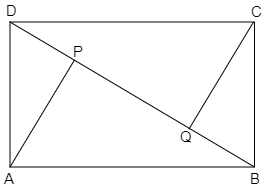
Answer
429.9k+ views
Hint: We will first start by using the fact that if two triangles are congruent then their corresponding parts are equal for proving two triangles congruent. We will use AAS congruence wherein we have to prove two angles and one side are equal.
Complete step by step solution:
Now, we have been given a parallelogram and AP and CQ are perpendicular drawn from vertices A and C and diagonal BD and we have to show that \[AP = CQ\].
Now, we know that the opposite sides of a parallelogram are parallel and equal. Therefore, we have,
$ \Rightarrow AD = BC$.................….. (1)
Also, we have $AD\parallel BC$ and we know that alternate interior angles formed by a transversal cutting a pair of parallel lines are equal. Therefore, we have,
$ \Rightarrow \angle ADB = \angle CBD$...............….. (2)
Now, we know that the angle formed by a straight line is $180^\circ $. Then, we have,
$ \Rightarrow \angle DPA = 90^\circ $
Similarly,
$ \Rightarrow \angle CQB = 90^\circ $
So, it implies that,
$ \Rightarrow \angle DPA = \angle CQB$...............….. (3)
Now, check whether $\Delta DPA$ and $\Delta BQC$ are congruent or not,
$ \Rightarrow \angle DPA = \angle BQC$ (from (3))
$ \Rightarrow AD = BC$ (from (1))
$ \Rightarrow \angle ADB = \angle CBD$ (from (2))
So, by ASA congruence,
$\Delta DPA \cong \Delta BQC$
Now, we know that by the corresponding part of the congruent triangle we have,
$\therefore AP = CQ$
Hence, proved.
Note: In these types of questions, we need to understand what sides and angles of the triangles are given to be equal and what can be proved. Finally, we need to use one of the congruence criteria(ASA, SAS, RHS, SSS, etc.) to prove that the triangles are congruent. Also, we need to understand what each of the congruence criteria means. Like in SAS, the angle should be the included angle between the two sides. Many students do not know this and hence arrive at incorrect results.
Complete step by step solution:
Now, we have been given a parallelogram and AP and CQ are perpendicular drawn from vertices A and C and diagonal BD and we have to show that \[AP = CQ\].
Now, we know that the opposite sides of a parallelogram are parallel and equal. Therefore, we have,
$ \Rightarrow AD = BC$.................….. (1)
Also, we have $AD\parallel BC$ and we know that alternate interior angles formed by a transversal cutting a pair of parallel lines are equal. Therefore, we have,
$ \Rightarrow \angle ADB = \angle CBD$...............….. (2)
Now, we know that the angle formed by a straight line is $180^\circ $. Then, we have,
$ \Rightarrow \angle DPA = 90^\circ $
Similarly,
$ \Rightarrow \angle CQB = 90^\circ $
So, it implies that,
$ \Rightarrow \angle DPA = \angle CQB$...............….. (3)
Now, check whether $\Delta DPA$ and $\Delta BQC$ are congruent or not,
$ \Rightarrow \angle DPA = \angle BQC$ (from (3))
$ \Rightarrow AD = BC$ (from (1))
$ \Rightarrow \angle ADB = \angle CBD$ (from (2))
So, by ASA congruence,
$\Delta DPA \cong \Delta BQC$
Now, we know that by the corresponding part of the congruent triangle we have,
$\therefore AP = CQ$
Hence, proved.
Note: In these types of questions, we need to understand what sides and angles of the triangles are given to be equal and what can be proved. Finally, we need to use one of the congruence criteria(ASA, SAS, RHS, SSS, etc.) to prove that the triangles are congruent. Also, we need to understand what each of the congruence criteria means. Like in SAS, the angle should be the included angle between the two sides. Many students do not know this and hence arrive at incorrect results.
Recently Updated Pages
Fill in the blanks with suitable prepositions Break class 10 english CBSE

Fill in the blanks with suitable articles Tribune is class 10 english CBSE

Rearrange the following words and phrases to form a class 10 english CBSE

Select the opposite of the given word Permit aGive class 10 english CBSE

Fill in the blank with the most appropriate option class 10 english CBSE

Some places have oneline notices Which option is a class 10 english CBSE

Trending doubts
Fill the blanks with the suitable prepositions 1 The class 9 english CBSE

How do you graph the function fx 4x class 9 maths CBSE

When was Karauli Praja Mandal established 11934 21936 class 10 social science CBSE

Which are the Top 10 Largest Countries of the World?

What is the definite integral of zero a constant b class 12 maths CBSE

Why is steel more elastic than rubber class 11 physics CBSE

Distinguish between the following Ferrous and nonferrous class 9 social science CBSE

The Equation xxx + 2 is Satisfied when x is Equal to Class 10 Maths

Differentiate between homogeneous and heterogeneous class 12 chemistry CBSE





